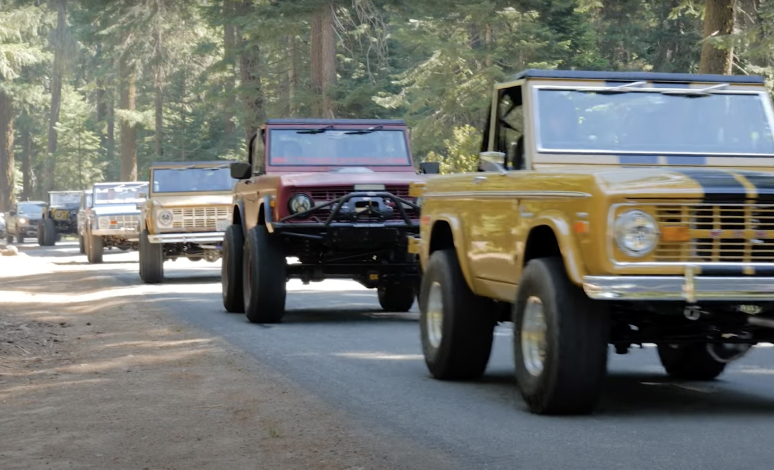Adjustable Tracking Bar Installation
Installation requires a professional mechanic. Prior to beginning, inspect the vehicles steering, driveline and brake systems, paying close attention to the suspension link arms and bushings, anti-sway bars and bushings, tie rod ends, pitman arm, ball joints and wheel bearings. Also check the steering sector-to frame and all suspension-to-frame attaching points for stress cracks. The overall vehicle must be in excellent working condition; repair or replace all worn parts.
Read instructions several times before starting. Be sure you have all needed parts and know where they install. Read each step completely as you go.

- This product is intended to center the frame / body in relation to the front axle tires.
- An arrow on diagrams indicates which direction is toward the front of the vehicle.
- A foot-pound torque reading is given in parenthesis ( ) after each appropriate fastener.
- Do not fabricate any components to gain additional suspension height.
- Prior attaching components, be sure all mating surfaces are free of grit, grease, undercoating, etc.
- A factory service manual should be on hand for reference.
How to Install Bronco Adjustable Tracking Bar
Prepare 66-77 Bronco…
Place vehicle in neutral. Raise front of vehicle with a jack and secure a jack stand beneath
each frame rail, behind the lower control arms. Ease the frame down onto the stands, place
transmission in low gear or “park,” and chock rear tires. Remove front tires.Prior to removing the bar, inspect the attaching points for movement while moving the steering wheel slightly from left-to-right. The bar-to-axle mounting stud is prone to work loose while the frame mounting bracket holes tend to elongate. If any of these conditions exist, repair before proceeding. Looseness can cause tire/wheel shimmy.
Remove the factory track bar from the vehicle and discard.
Adjustable Tracking Bar Installation…
With the track-bar off of the vehicle, center the frame / body over the axle / tires by simply
turning the steering wheel. An accurate centering method is to position a bubble-level
vertically at the wheel well’s center, to act as a fender reference plane. Then, on each side,
measure from it to the tire’s outer sidewall. Shift the frame / body, via the steering wheel, so that each side’s measurement is the same.With the axle centered under the vehicle, measure the eye-to-eye distance of the track bar
mounts on the vehicle, then adjust the new track bar length accordingly.NOTE: Maximum exposed thread length is 3″. Generally, this allows for up to 9″ of suspension lift on pickups or 6″ of lift on early model Broncos.
Insert the furnished Polyurethane bushings / steel wear sleeves into the appropriate bar eyes using a silicone-based grease.
Install bar with the adjustable end towards the frame. The bar’s main bend points toward the front of vehicle in order to clear the front differential
Final Procedures…
Re-check body alignment as per step (2).
Tighten the bar’s jam nut. Install the attaching points, castellated nuts, and cotter pins.NOTE: Check jam nut tightness periodically. If vehicle is operated while the nut is loose, thread wear will occur.
Final Clearance and Torque Check…
With vehicle on floor, cycle steering lock-to-lock and inspect the tires / wheels, and the
steering, suspension and brake systems for proper operation, tightness and adequate clearance.
IMPORTANT PRODUCT USE INFORMATION
As a general rule, the taller a vehicle is, the easier it will roll over. Offset, as much as possible, what is lost in roll over resistance by increasing tire track width. In other words, go “wide” as you go “tall”.
Many drivers remove their mud tires after winter / hunting season and install ones more appropriate for street driving; always use as wide a tire and wheel combination as possible to enhance vehicle stability.
We strongly recommend, because of roll over possibility, that the vehicle be equipped with a functional roll bar and cage system. Seat belts and shoulder harnesses should be worn at all times. Avoid situations where a side rollover may occur.
Generally, braking performances and capabilities are decreased when significantly larger / heavier tires and wheels are used. Take this into consideration while driving.
Do not add, alter or fabricate any factory or aftermarket parts to increase vehicle height over the intended height of this product.
Most states have some type of law limiting vehicle height. The amount of lift allowed, and how the lift may be achieved, varies greatly. Several states offer exemptions for farm or commercially registered vehicles.
More Ways To Get Help & Learn More
